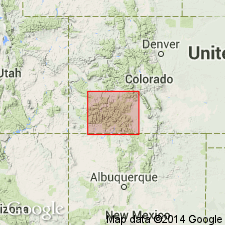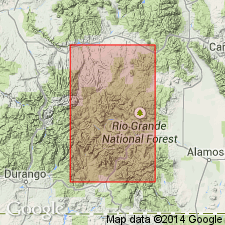
- Usage in publication:
-
- Blanco Basin formation*
- Modifications:
-
- Original reference
- Dominant lithology:
-
- Sandstone
- Conglomerate
- AAPG geologic province:
-
- San Juan basin
- San Juan Mountains province
- San Luis basin
Summary:
[Credited to Larsen.] Blanco Basin formation. In many places on south slopes of San Juan Mountains, in San Cristobal, Pagosa Springs, Summitville, and Conejos quadrangles, southwestern Colorado, a series of arkosic sandstones, conglomerates, and other sediments, lacking in volcanic material, unconformably overlies Cretaceous formations and Animas formation (Eocene?) and are overlain, with apparent conformity, by Conejos andesite (Miocene). The name Blanco Basin formation is proposed for these beds, from their prominent development about Blanco Basin, [in T. 34 and 35 N., R. 1 and 2 E.], in central part of Summitville quadrangle, [Archuleta County], southwestern Colorado. Is in general a thin, soft formation, overlying in many places Mancos shale and overlain by great thickness of volcanic breccia. It is imperfectly known and only approximately mapped. East of Chama River, near southern boundary of Summitville quadrangle, it is 575 feet thick, is overlain by several hundred feet of beds belonging to Conejos andesite, and rests with angular unconformity on Mancos shale. Age is Tertiary (Oligocene?).
Source: US geologic names lexicon (USGS Bull. 896, p. 212).

- Usage in publication:
-
- Blanco Basin Formation*
- Modifications:
-
- Age modified
- AAPG geologic province:
-
- San Juan Mountains province
Summary:
Pg. D49, D50. Blanco Basin Formation. Age is changed from Oligocene(?) --to-- early Eocene. (Adopted by the USGS.) No fossils. [Age assignment based on lithologic correlation and on interpreted structural-stratigraphic relationships.] Cross and Larsen, 1935 (USGS Bull. 843, p. 47) and Larsen and Cross, 1956 (USGS Prof. Paper 258, p. 61) assigned the Blanco Basin Formation, and the apparent correlative Telluride Formation, to the Oligocene(?). Van Houten, 1957 (GSA Bull., v. 68, p. 386) and recently, Dunn, 1964 (Univ. Texas unpub. PhD thesis, p. 43) correlated the arkosic fluviatile beds of the Blanco Basin Formation in the southern part of the volcanic field with similar arkosic beds of the San Jose Formation in the central part of the San Juan basin. (Age of San Jose considered early Eocene based on vertebrate fossils, citing Simpson, 1948, Amer. Jour. Sci., v. 246, no. 5, p. 257-282, and no. 6, p. 363-385.)
Source: Publication; Changes in stratigraphic nomenclature, 1968 (USGS Bull. 1294-A, p. A3).
For more information, please contact Nancy Stamm, Geologic Names Committee Secretary.
Asterisk (*) indicates published by U.S. Geological Survey authors.
"No current usage" (†) implies that a name has been abandoned or has fallen into disuse. Former usage and, if known, replacement name given in parentheses ( ).
Slash (/) indicates name conflicts with nomenclatural guidelines (CSN, 1933; ACSN, 1961, 1970; NACSN, 1983, 2005, 2021). May be explained within brackets ([ ]).

